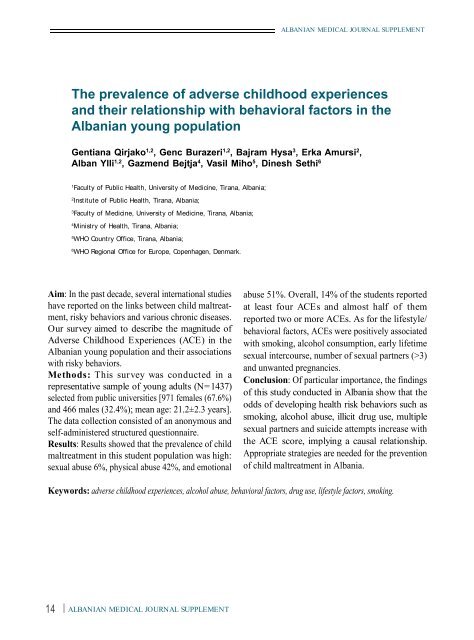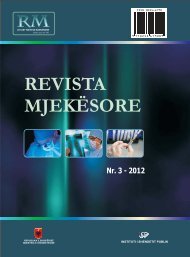in Albania - Instituti i Shendetit Publik
in Albania - Instituti i Shendetit Publik
in Albania - Instituti i Shendetit Publik
You also want an ePaper? Increase the reach of your titles
YUMPU automatically turns print PDFs into web optimized ePapers that Google loves.
ALBANIAN MEDICAL JOURNAL SUPPLEMENTThe prevalence of adverse childhood experiencesand their relationship with behavioral factors <strong>in</strong> the<strong>Albania</strong>n young populationGentiana Qirjako 1,2 , Genc Burazeri 1,2 , Bajram Hysa 3 , Erka Amursi 2 ,Alban Ylli 1,2 , Gazmend Bejtja 4 , Vasil Miho 5 , D<strong>in</strong>esh Sethi 61Faculty of Public Health, University of Medic<strong>in</strong>e, Tirana, <strong>Albania</strong>;2Institute of Public Health, Tirana, <strong>Albania</strong>;3Faculty of Medic<strong>in</strong>e, University of Medic<strong>in</strong>e, Tirana, <strong>Albania</strong>;4M<strong>in</strong>istry of Health, Tirana, <strong>Albania</strong>;5WHO Country Office, Tirana, <strong>Albania</strong>;6WHO Regional Office for Europe, Copenhagen, Denmark.Aim: In the past decade, several <strong>in</strong>ternational studieshave reported on the l<strong>in</strong>ks between child maltreatment,risky behaviors and various chronic diseases.Our survey aimed to describe the magnitude ofAdverse Childhood Experiences (ACE) <strong>in</strong> the<strong>Albania</strong>n young population and their associationswith risky behaviors.Methods: This survey was conducted <strong>in</strong> arepresentative sample of young adults (N=1437)selected from public universities [971 females (67.6%)and 466 males (32.4%); mean age: 21.2±2.3 years].The data collection consisted of an anonymous andself-adm<strong>in</strong>istered structured questionnaire.Results: Results showed that the prevalence of childmaltreatment <strong>in</strong> this student population was high:sexual abuse 6%, physical abuse 42%, and emotionalabuse 51%. Overall, 14% of the students reportedat least four ACEs and almost half of themreported two or more ACEs. As for the lifestyle/behavioral factors, ACEs were positively associatedwith smok<strong>in</strong>g, alcohol consumption, early lifetimesexual <strong>in</strong>tercourse, number of sexual partners (>3)and unwanted pregnancies.Conclusion: Of particular importance, the f<strong>in</strong>d<strong>in</strong>gsof this study conducted <strong>in</strong> <strong>Albania</strong> show that theodds of develop<strong>in</strong>g health risk behaviors such assmok<strong>in</strong>g, alcohol abuse, illicit drug use, multiplesexual partners and suicide attempts <strong>in</strong>crease withthe ACE score, imply<strong>in</strong>g a causal relationship.Appropriate strategies are needed for the preventionof child maltreatment <strong>in</strong> <strong>Albania</strong>.Keywords: adverse childhood experiences, alcohol abuse, behavioral factors, drug use, lifestyle factors, smok<strong>in</strong>g.14 ALBANIAN MEDICAL JOURNAL SUPPLEMENT




